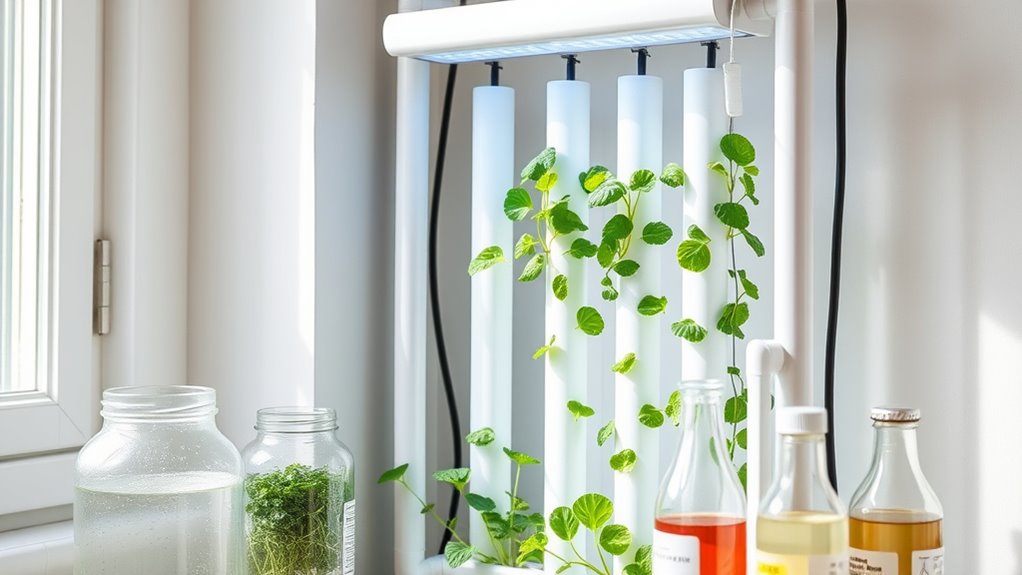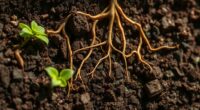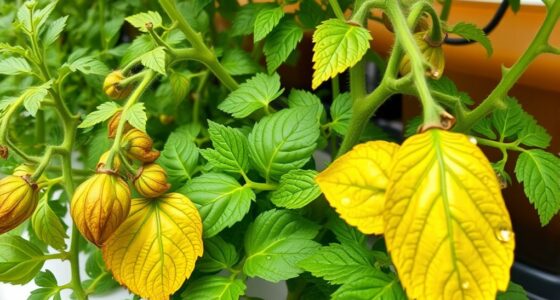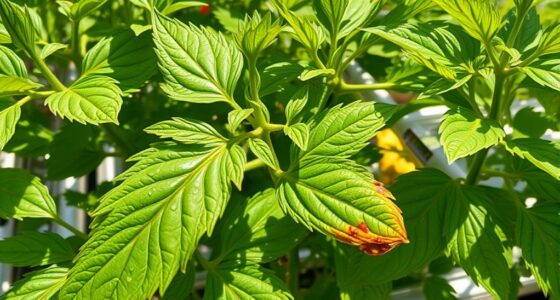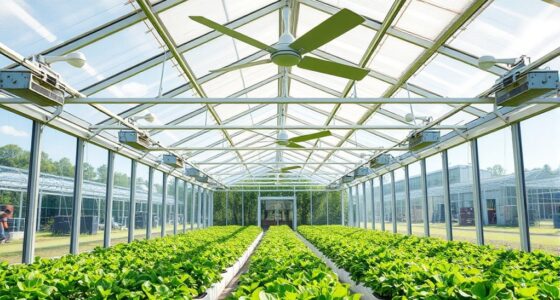To design a compact hydroponic setup in small spaces, focus on vertical gardening and tiered shelves to maximize growth area without taking up extra floor space. Use wall-mounted systems and stacked containers for efficient nutrient delivery, ensuring plants get balanced nutrition through reservoirs and pumps. Maintain proper pH levels for healthy growth and keep systems simple to manage. Keep exploring how to optimize your setup to grow a variety of herbs and greens effortlessly.
Key Takeaways
- Utilize vertical gardening to maximize limited space with stacked plant layers and tiered hydroponic systems.
- Opt for wall-mounted or tiered shelves that support multiple plant sites for efficient space use.
- Incorporate compact reservoirs and gravity-fed or pump systems to deliver nutrients effectively in small setups.
- Maintain proper pH levels (5.5-6.5) and automate nutrient delivery to ensure balanced plant nutrition.
- Focus on easy access and maintenance to promote healthy growth and simplify system management in confined areas.

If you’re short on space but still want to grow fresh produce at home, hydroponics offers an effective solution. One of the most efficient ways to maximize your limited area is through vertical gardening. Instead of spreading your plants out horizontally, you can stack them vertically, creating multiple layers of greenery in a compact footprint. This approach is perfect for small apartments, balconies, or even window sills. Vertical gardening allows you to utilize every inch of available space, making it possible to grow a variety of herbs, leafy greens, or small vegetables without cluttering your environment.
Maximize small spaces with vertical hydroponic gardening for fresh herbs and greens.
In designing your compact hydroponic setup, consider using wall-mounted systems or tiered shelves that support multiple plant sites. These setups often come with built-in channels or containers to hold your plants and their nutrient solutions. With vertical gardening, you’ll be able to access your plants easily while maintaining *crucial* light exposure. It also improves air circulation around your crops, reducing the risk of disease. By stacking your plants upward, you effectively increase your growing capacity without needing a larger floor area.
Nutrient solutions are the backbone of any hydroponic system, especially in tight spaces. Since you’re growing vertically, you’ll want a reliable method to deliver nutrients directly to your plants’ roots. Many vertical systems incorporate reservoirs that hold the nutrient solutions, which are then pumped or gravity-fed to the plant sites. It’s *essential* to monitor and maintain the right balance of nutrients—nitrogen, phosphorus, potassium, and trace minerals—to promote healthy growth. Using premixed nutrient solutions designed for hydroponics makes this process straightforward and helps *guarantee* your plants get a balanced diet.
Regularly checking the pH level of your nutrient solutions is also *imperative*. Small-scale setups are particularly sensitive to imbalances, which can hinder plant uptake of nutrients. Keep the pH within the *ideal* range for your specific crops, usually between 5.5 and 6.5. This *ensures* your plants absorb nutrients efficiently and stay healthy. Since space is limited, you’ll want a system that’s easy to top off and clean. Automated or semi-automated nutrient delivery systems can save you time and effort, allowing you to focus on enjoying your thriving garden.
Frequently Asked Questions
What Are the Best Crops for Small Hydroponic Setups?
You should grow herb varieties like basil, mint, and cilantro, as they thrive in small hydroponic setups. For fruit types, strawberries and cherry tomatoes are excellent choices because they produce well in limited space. These crops grow quickly, require minimal space, and give you fresh, flavorful harvests. By focusing on these options, you maximize your small hydroponic system’s productivity and enjoy a variety of herbs and fruits year-round.
How Much Does a Compact Hydroponic System Typically Cost?
A compact hydroponic system usually costs between $50 and $300, depending on size and features. With a clear cost analysis, you can plan your budget effectively. Smaller setups with basic components tend to be affordable, making hydroponics accessible for beginners. As you budget plan, consider equipment quality and growth potential—investing a bit more can boost your yield and system durability, ensuring a successful, space-efficient garden.
What Maintenance Is Required for Small Hydroponic Gardens?
You need to regularly check pH balancing to keep your small hydroponic garden healthy, usually weekly. Clean your system to prevent algae growth, which can clog your setup and harm plants. Replace nutrients as needed and inspect pumps and filters for proper operation. Keep an eye on water levels, and guarantee your environment stays clean and stable to promote healthy plant growth in your compact system.
Can Hydroponics Be Integrated Into Indoor Living Spaces?
Yes, you can easily integrate hydroponics into your indoor living spaces. Use indoor lighting to guarantee your plants get enough light, and focus on space optimization by choosing compact, multi-purpose setups that fit seamlessly into your home. With careful planning, you’ll create a thriving hydroponic garden without sacrificing style or functionality. It’s a smart way to enjoy fresh herbs and veggies right in your living area.
What Are Common Challenges in Small-Space Hydroponic Gardening?
You’ll often face challenges like space limitations, which make it tricky to set up and maintain your system properly. Nutrient management can also be complex, as small setups require precise adjustments to keep plants healthy. You might struggle with airflow and lighting, too, since limited space restricts these essentials. To succeed, plan carefully, monitor nutrient levels closely, and optimize your space to make certain your hydroponic garden thrives.
Conclusion
Now that you know how to maximize small spaces with hydroponics, it’s exciting to see just how efficient these setups can be. Did you know that small-scale hydroponic systems can produce up to 25% more yield than traditional soil gardening in the same space? This proves that with smart design and technique, you can grow fresh, healthy produce even in tight spots. So, get started—your green thumb and limited space can make a big difference!

